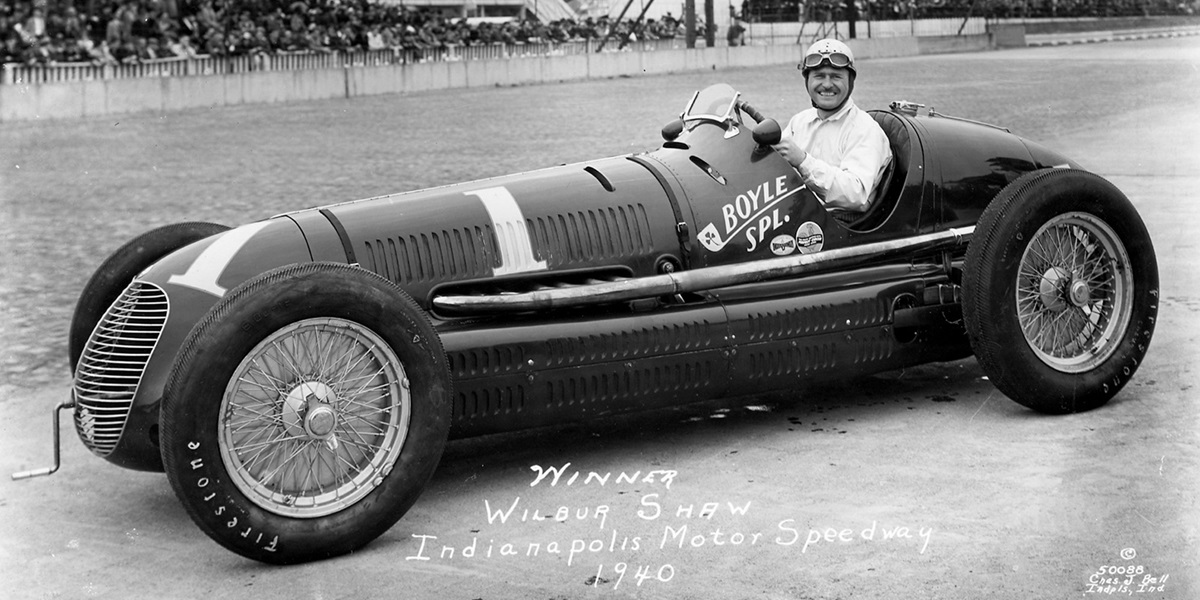
Shaw Writes History, Caps Amazing String of Indy 500 Success in 1930s
April 03, 2020 | By Zach Horrall, Indianapolis Motor Speedway
When race fans think of dominant drivers of the Indianapolis 500, they likely think of A.J. Foyt in the 1960s, Al Unser in the 1970s or Rick Mears in the 1980s. But who dominated the historic 2.5-mile oval before them and paved a way for these iconic names?
Wilbur Shaw.
Race fans likely have heard of Shaw, the legendary three-time “500” winner who convinced Tony Hulman to purchase the dilapidated racetrack after World War II. But before his time running the day-to-day operations of the Speedway as president and general manager of the Indianapolis Motor Speedway, Shaw was one of the best drivers in the early years of the “500.”
Shaw’s massive influence on the Speedway started with his stellar on-track performance in the 1930s and into the 1940s.
In 1933 and 1935, Shaw finished second in the Indy 500. Then, from 1937 through 1940, Shaw finished first, second, first and first, respectively.
“Wilbur was the most outstanding driver of the first 30 or so years of the Indianapolis 500,” Indianapolis Motor Speedway Historian Donald Davidson said of the last Hoosier native to win the 500-mile race. “He had the best record of any driver.”
Shaw’s on-track success at Indianapolis was capped off when he wrote a significant piece of Indianapolis 500 history in 1940.
Eighty years ago, Shaw won the 28th Running of the Indianapolis 500 and became the first driver to win back-to-back 500-mile races. Driving the No. 1 car, he became the race’s second three-time winner, behind Louis Meyer.
As was the case in those days, Shaw showed up to the racetrack with confidence and momentum. He won the 1939 edition of the race driving the exact same Boyle Special Maserati he entered in 1940. While Meyer beat him to a record three Indy 500 wins, Shaw still had a chance to write his page of history at the Racing Capital of the World.
When Shaw hit the track in 1940, it was almost like nothing had changed. He started second in the race and stayed near the front all day, leading 136 of the 200 laps. While Shaw had a strong car, he also had help from Mother Nature.
With 100 miles to go, light rain began to fall at the Speedway. As was customary in those times, the race was not halted for light rain. However, the caution did come out, and the remainder of the race was run under caution and in the rain.
Therefore, Shaw easily led Rex Mays and Mauri Rose to the finish and capped an extraordinary run at the Speedway that is unlikely to be matched.
Following his amazing performance at the Indy 500, the racetrack was shut down starting in 1942 due to World War II. Shaw took a job at Firestone Tire and Rubber Company in Akron, Ohio, heading up Firestone’s new aircraft division.
Then in 1944, Shaw and Firestone received permission from the government to test a synthetic rubber tire they were experimenting with that could be used for street cars once the war was over.
Shaw, who was born about 40 miles southeast of the Speedway in Shelbyville, Indiana, wanted to test at his beloved Indianapolis Motor Speedway.
But when he and the Firestone team arrived, the Speedway was in terrible shape. The track had laid dormant during the war, and weeds were overgrowing every aspect of the track. They even had to “weed the groove” before their test could begin.
It was around this time Shaw learned IMS owner Eddie Rickenbacker might be prepared to sell the track. Shaw was determined not to let his beloved Speedway fall into someone else’s hands, and he went on a mission to find the right buyer that could save the Speedway.
Shaw’s mission took him several places, but it eventually led to Terre Haute, Indiana, and businessman Hulman, whom Shaw nudged to purchase the Speedway and bring “The Greatest Spectacle in Racing” back from hiatus.
Hulman instilled Shaw as track president and general manager, and the two ran the Speedway together for nine years until Shaw died in a plane crash in 1954.
“Wilbur Shaw is one of the most important people in the history of the Indianapolis Motor Speedway,” Davidson said. “I think if you try to make the Mount Rushmore of the Indianapolis Motor Speedway, and you’re up to five or six people and you don’t have Wilbur Shaw yet, you’ve got it wrong.”